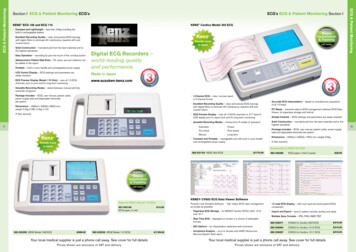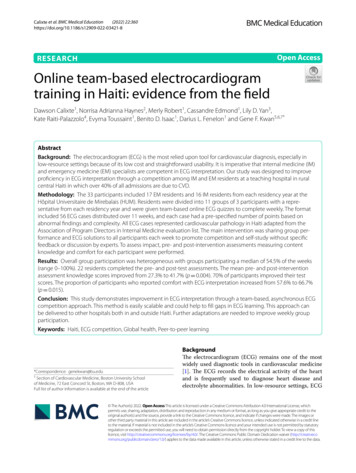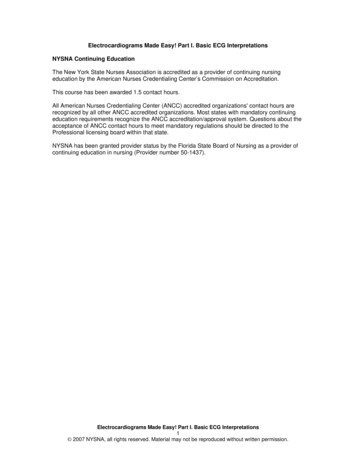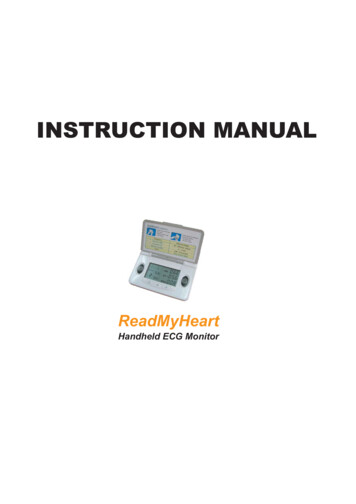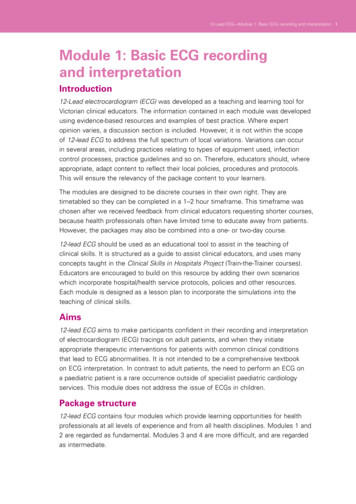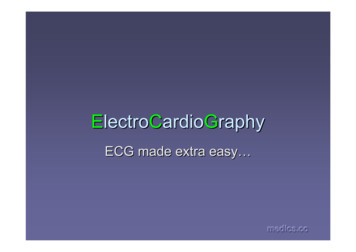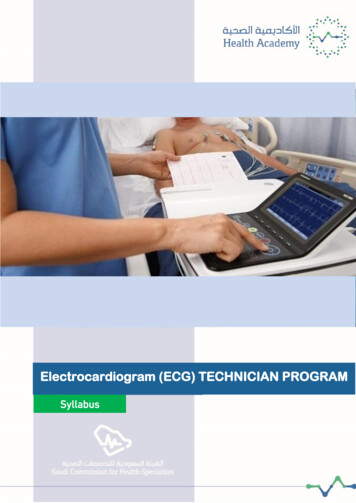
Transcription
Page 3Electrocardiogram (ECG) TECHNICIAN PROGRAMSyllabus
Table of ContentsINTRODUCTION . 1Program Overview . 1Program Description . 1Vision . 2Mission . 2PROGRAM GOAL AND COMPETENCIES . 2Goal . 2Teaching Strategies . 2Program Competencies . 3Knowledge and Skills Related to Coordinated Patient Care. 3Occupational Safety and Infection Control . 3Language and Communication Skills and Techniques . 4Basic Cardiovascular Knowledge on Anatomy and Physiology . 4Basic Cardiovascular Pharmacology . 5Basic Cardiovascular Pathophysiology . 5Basic ECG Knowledge and Skills . 5Advanced Knowledge and Skills in ECG Interpretation and Monitoring . 6PROGRAM SYLLABUS . 7ASSESSMENT AND GRADING CRITERIA. 8PROGRAM REFERENCES . 9Block I . 9Block II. 9Block III . 9Block IV . 10Other Learning Resources:. 10
Page 1INTRODUCTIONProgram OverviewElectrocardiogram (ECG) is one of the basic and primary diagnostic procedures that is used tomake a diagnosis of heart diseases for both adult and pediatric patients. A proper ECG stripcan provide the cardiologist with accurate details of the patient’s status and help to decide thetreatment plan. Most of ECGs are done by healthcare workers who are not properly trained toperform and analyze ECG e.g. nurses, nurse aid, etc. To ensure accuracy and best outcomes,ECG should be performed by professionals, who are adequately trained through a nationallyaccredited ECG program that enables them to perform as well as analyze the strips to makefaster diagnosis and save time for appropriate treatment.Program DescriptionThe Electrocardiogram (ECG) Technician program aims to provide the theoretical knowledgeand the practical competencies required to perform the electrocardiographic exams necessaryfor the identification of cardiovascular disorders and heart diseases (congenital or acquired).With an overall length of 4 blocks (one year), the ECG Technician Program is a full-time coursethat includes theoretical lectures, workshops and supervised clinical practice across severalinpatient and outpatient settings enhancing an overall comprehension of electrocardiographyin adult and pediatric patients.With a clinical exposition throughout all the length of the program, the theoretical contents ofthis course are divided into different modules allowing a progressive comprehension of theseveral scientific and technological subjects.Upon the successful completion of this program, the trainee(s) will be able to competentlyperform electrocardiographic exams, correlating the findings with the clinical evidence andenhancing the identification of several cardiovascular pathologies. The trainee(s) will also beable to contribute to the organizational quality improvement projects, being competent to leador participate in research projects in this area.This program is designed for those who hold a degree in Bachelor of Science.Electrocardiogram (ECG) program: 4 blocks (1 year)
Page 2VisionTo provide a world-class training program in the field of electrocardiography technology.MissionTo promote the profession of electrocardiography technology among Saudi men and womeninterested in joining healthcare services to increase the workforce in healthcare and to servethe national health system with graduates in electrocardiography technology.PROGRAM GOAL AND COMPETENCIESGoalThe goal of the program is to prepare competent entry-level ECG Technicians with strongknowledge, skills and affective behavior learning domains who can fulfil the country-wide ECGneeds.Teaching Strategies Interactive theoretical lecture and discussion Laboratory and practical field learning Bedside clinical skills competencies Case-based learning Problem Based Learning (PBL) Presentation by trainees Group discussion Seminar and tutorial Independent self-study E-learning
Page 3 Continuous assessment Quizzes Assignments Case Report Written Exam Multiple choice Essay questions Objective Structured Clinical Examination (OSCE) Objective Structured Practical Examination (OSPE)Program CompetenciesKnowledge and Skills Related to Coordinated Patient Care Describe factors affecting healthcare environment and patient safety Understand the specifications for standard patient identification and patient privacy Demonstrate competency in applying the patient / procedure matching protocols Identify the patient rights and responsibilities Discuss key factor required to educate patients about the procedure Apply safe patient transfer and transport standards (e.g., body mechanics andergonomics) Discuss principles of effective communication and patient education Describe patient identification standards and documentation process Identify high-alert ECG findings and take the appropriate action Apply principles of medical ethics in clinical practice Demonstrate appropriate professional behavior towards patients Apply effective communication skills in the clinical settings Practice patient education skills in relation to the ECG procedureOccupational Safety and Infection Control Explain the universal infection prevention and control precautions Identify medical procedure associated with risk of radiation exposure Demonstrate various strategies to handle and minimize radiation exposure Identify the human-machine environment relationship
Page 4 Apply work ergonomics as a tool for healthier and safer work conditions Participate in programs designed to ensure employee health and safetyLanguage and Communication Skills and Techniques1. Healthcare Communication - General English Name common English grammar rules Identify common English grammar mistakes Understand English structure, sentence types, and part of speech Apply effectively the basic English language communication Demonstrate command of the conventions of standard English grammar Show of use of proper capitalization, punctuation, and spelling when writing2. Medical Terminology Demonstrate the benefit of using medical terminology Identify the common medical terminology prefixes, suffixes, and word roots Recognize and match common Cardiovascular abbreviations and their meaning Describe the use of common cardiovascular medical terminologies3. Computer Skills Understand the importance of utilizing electronic medical record in health caresetting. Demonstrate adequate communication skills using telephone or emails inhospital setting Perform basic troubleshooting of cardiac information management systemrelated to ECG.Basic Cardiovascular Knowledge on Anatomy and Physiology1. Anatomy Describe the location and position of the heart within the body cavity Describe the internal and external anatomy of the heart Identify the tissue layers of the heart Relate the structure of the heart to its function as a pump Compare systemic circulation to pulmonary circulation Identify the veins and arteries of the coronary circulation system Trace the pathway of oxygenated and deoxygenated blood thorough thechambers of the heart
Page 52. Physiology Relate heart rate to cardiac output Describe the effect of exercise on heart rate Identify cardiovascular centers and cardiac reflexes that regulate heart function Describe factors affecting heart rate Distinguish between positive and negative factors that affect heart contractility Summarize factors affecting stroke volume and cardiac output Describe the cardiac response to variations in blood flow and pressure Describe the relationship between blood pressure and blood flow Summarize the events of the cardiac cycle Compare atrial and ventricular systole and diastole Relate heart sounds detected by auscultation to action of heart’s valvesBasic Cardiovascular Pharmacology Describe the general principles of pharmacology Identify and describe drugs that affect the cardiovascular system Explain drugs that affect the Autonomic Nervous System (ANS) Discuss drugs that affect the Central Nervous SystemBasic Cardiovascular Pathophysiology Describe heart failure, underlying mechanism and signs & symptoms List types of heart failure and signs and symptoms Explain ischemic process and early & late changes in infarction Identify key complications and clinical presentations of myocardial infarction Discuss atherosclerosis process, stages of plaque development, risk factors andcomplications of atherosclerotic plaques Identify cardiac disease that affect conduction systemBasic ECG Knowledge and Skills Apply the gained knowledge to perform ECG across various ECG machines Identify normal electrocardiographic rhythm Explain atrial activation and repolarization, P-wave, and heart rate variability Describe the atrioventricular node conduction and the PR-Segment Discuss the ventricular activation and the terminology for the QRS complex
Page 6 Understand the sequency of ventricular recovery, normal ST-wave, and normalvariant Demonstrate competency in analyzing normal ECG rhythm Define all the components of ECG graph Describe systematic interpretation of abnormal ECG Identify each abnormal ECG rhythms Explain the clinical significance of each abnormal ECG Define abnormal ECG rhythms associated with the SA Node, Atria, AV node,ventricles Explain diagnostic criteria and clinical significance of ventricular hypertrophy,various interventricular conduction delays, and myocardial ischemia or infarction Identify the localization of ischemia or infarction Demonstrate skills to analyze normal ECG Rhythm strips Apply the gained knowledge to read normal ECG rhythms Identify clinical criteria of normal ECG strips. Demonstrate essential skills to properly operate the ECG machine Demonstrate basic equipment hardware maintenance and troubleshooting Apply principle of cleaning and maintaining equipment and instruments such ascardiac (ECG) monitor, telemetry transmitter cables, electrodes, and centralmonitor, strip recorders, and central printers Demonstrate their ability to communicate with Bio Medical Engineering staff tomaintain and repair the equipment in case of emergency situations.Advanced Knowledge and Skills in ECG Interpretation and Monitoring List types of ambulatory ECG monitoring and their diagnostic efficacy Describe when to use continuous ECG (Holter) monitoring, event monitoring, andmobile cardiac outpatient telemetry (MCOT) List types of exercise testing, advantages and disadvantages Explain Indications, Contraindications, limitations Describe different stages of exercise test procedure Discuss the ECG abnormalities during exercise and during recovery Demonstrate skills to analyze normal ECG Rhythm strips, Apply the gained knowledge to read normal ECG rhythms Identify clinical criteria of normal ECG strips.
Page 7PROGRAM SYLLABUSThe required period for completion of this program is one calendar yearModule NameTotalCreditTotal ContactTheoryPracticalDurationBlock IVBlock IIIBlock IIBlock IHour1. Healthcare Communication23002. Medical Terminology23003. Patient Care Skills11504. Cardiac Anatomy and Physiology23005. Basic Pharmacology11506. Fundamental Principles of ECG34507. Pathophysiology23008. ECG Rhythm Analysis23009. Clinical Practicum I4012010. Advanced ECG Diagnostics230011. Clinical Practicum II60180279 Weeks9 Weeks9 Weeks9 Weeks555Internship5403 MonthsTotal1095 hours48 weeks
Page 8ASSESSMENT AND GRADING CRITERIATable 1: Assessment and Evaluation Scheme for Program Completion - TheoreticalAssessment andAssessment ToolsWeightGrading SystemAttendance and participation10%Continuous Assessment20% 2 Quizzes (2 X 5 marks) 10% Assignments 10%Midterm Exam 30%Written ExaminationEnd of the Block Assessment 40%Final Written ExaminationTotal100%Passing Score70%Final GradingPass/FailTable 2: Assessment and Evaluation Scheme for Program Completion - PracticalAssessment andAssessment ToolsWeightGrading SystemAttendance and participation10%Continuous Assessment40% Bedside competencies 20% Case-based discussion 20%End of Block Assessment 50% 50%Objective Structured ClinicalExamination (OSCE)Total100%Passing Score70%Final GradingPass/Fail
Page 9PROGRAM REFERENCESBlock I1.The Language of Medicine by Davi-Ellen Channer, 11th edition; Manufacturer No, ISBNNumber 97803233708132.Essentials of Sonography and Patient Care; Marveen Craig, 2nd Edition, 2016. ISBN:139781416001706Block II1.Essentials of Anatomy and Physiology, By Valerie C. Scanlon, Tina Sanders, 8th edition,ISBN10 0803669372, ISBN13 97808036693762.Human Anatomy and Physiology, an Open Stax College resource, ISBN-13: 978-1-93816813-0 (Available as PDF Book).3.CARDIAC DRUG THERAPY, Seventh Edition by M. GABRIEL KHAN, MD, FRCP, FACC,Associate Professor of Medicine, University of Ottawa, and Cardiologist, The OttawaHospital, Ottawa, Ontario, Canada (Available as PDF Book).4.Brenner and Stevens’ Pharmacology, 5th Edition, Craig Stevens George Brenner, eBookISBN: 9780323391689, Paperback ISBN: 97803233916655.Pathophysiology of Heart Disease, A Collaborative Project of Medical Students and Faculty,Editor Leonard S. Lilly, 5th Edition, ISBN 978-1-60547-723-7 (Available as PDF Book).6.Pathophysiology of Heart Disease, 4th ed. Philadelphia, Lippincott Williams & Wilkins,2007.7.Heart Physiology and Pathophysiology, 4th Edition, Yoshihisa Kurachi Andre Terzic MichaelCohen, eBook ISBN: 9780080533889, Hardcover ISBN: 9780126569759Block III1.The ECG Made Easy, By John R. Hampton, Churchill Livingstone, 8th Edition, 2013.2.ECG interpretation made incredibly easy, 5th ed.by Lippincott Williams & Wilkins. 2011ISBN 978-1-60831-289-43.The Only EKG Book You’ll Ever Need, 8th edition. Thaler. Lippincott Williams and Wilkins.20154.Rapid Interpretation of EKG's, Sixth Edition 6th Revised ed. Edition by Dale Dubin (Author)ISBN-13: 978-09129120665.Goldberger’s Clinical electrocardiography, A simplified approach, ninth Edition.6.ECG Diagnosis: A Self-Assessment Workbook, Edward K. Chaung, M, Thomas JeffersonUniversity Hospital, ISBN: 0-86542- 587-6 (available as PDF Book).
P a g e 107.Cardiac Pacemakers and Defibrillators, Second Edition. Charles J. Love, M.D. Ohio StateUniversity Medical Center, Columbus, Ohio. ISBN: 1-57059-691-3 (available as PDF Book).Block IV1.Braunwald’s Heart Disease A Textbook of Cardiovascular Medicine. Volume 1. Ninth Edition2.Chareonthaitawee. P., Askew. W.J, (2021) Exercise ECG testing: Performing the test andinterpreting the ECG results. UpToDate. Retrieved May 22, 2021 fromhttps://www.uptodate.com3.Crawford. H. Michael et al. ACC/AHA Guidelines for Ambulatory Electrocardiography:Executive Summary and Recommendations. Originally published 24 Aug1999https://doi.org/10.1161/01.CIR.100.8.886 Circulation. 1999; 100:886–8934.NAHQ. HQ Solutions: Resource for the Healthcare Quality Professional. Wolters KluwerHealth. Kindle Edition.5.Pelletier. R. Luc., Beaudin. L. C. (2017) HQ Solutions: Resource for the Healthcare QualityProfessional. Wolters Kluwer Health.6.Prutkin. M. Jordan, (June 10 2019). ECG tutorial: Basic principles of ECG analysis.UpToDate. Retrieved May 22, 2021 from https://www.uptodate.com7.Sandau, E.K et al. (2017). Update to Practice Standards for ElectrocardiographicMonitoring in Hospital Settings: A Scientific Statement From the American HeartAssociation, Circulation; 136:e273–e344. e A. Dennis. (2020). Pocket Guide to Stress Testing (2nd Edition). Wiley.Other Learning Resources:1.Clinical Procedures for Safer Patient Care. https://opentextbc.ca/clinicalskills/For more information, please visit COAMS Library ain.asp3.http://en.ecgpedia.org/wiki/Main acticalclinicalskills.com/
Demonstrate competency in analyzing normal ECG rhythm Define all the components of ECG graph Describe systematic interpretation of abnormal ECG Identify each abnormal ECG rhythms Explain the clinical significance of each abnormal ECG Define abnormal ECG rhythms associated with the SA Node, Atria, AV node, ventricles
